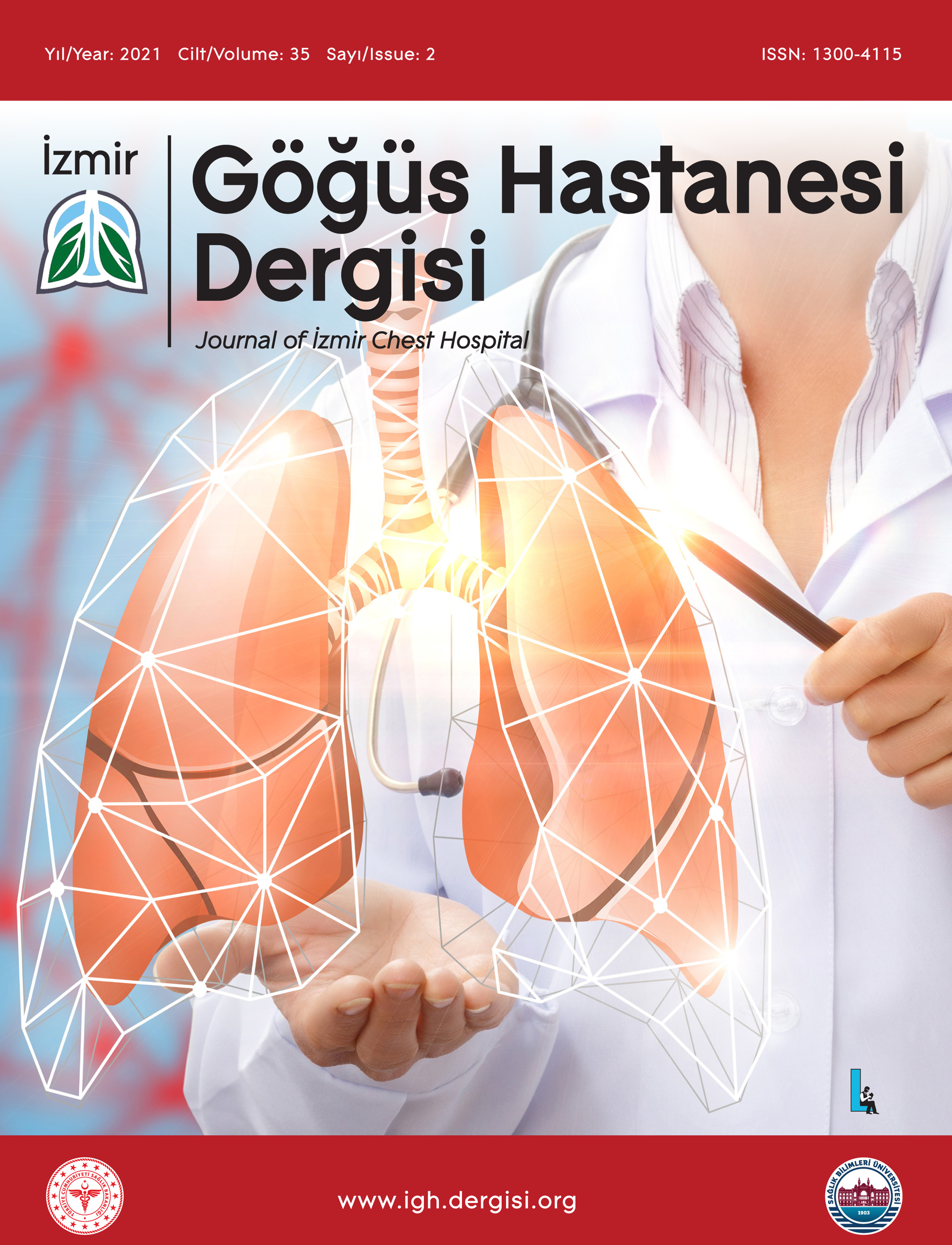Dış Ortam Hava Kirliliği ile Göğüs Hastalıkları Acil Başvuruları İlişkisinin Değerlendirilmesi: Retrospektif Kesitsel Bir Çalışma
Berker Öztürk1, Mükremin Er2, Hatice Canan Hasanoğlu31Aksaray Eğitim ve Araştırma Hastanesi Göğüs Hastalıkları Anabilim Dalı, Aksaray, Türkiye2Ankara Şehir Hastanesi Göğüs Hastalıkları Anabilim Dalı, Ankara, Türkiye
3Göğüs Hastalıkları Anabilim Dalı, Ankara Yıldırım Beyazıt Üniversitesi Tıp Fakültesi, Ankara, Türkiye
Amaç: Hava kirliliği, akciğerde ve akciğer aracılığıyla sistemik dolaşıma ulaşarak solunum fonksiyonlarında azalmaya, solunum yolu enfeksiyonlarına, astım ve kronik obstrüktif akciğer hastalığı gelişimine ve alevlenmelerin artışına sebep olur. Literatürde Ankara ilinde hava kirliliği ile alt solunum yolu enfeksiyonu acil servis başvurularını gösteren çalışma mevcut değildir. Bu çalışmada, acil servise başvuran göğüs hastalıkları bulunan hastaların başvuru oranlarının hava kirliliği ile ilişkisinin gösterilmesi amaçlandı.
Gereç ve Yöntemler: Çalışmaya, Ağustos 2018-Şubat 2019 tarihleri arasında Ankara Atatürk Eğitim ve Araştırma Hastanesi Acil Servisine göğüs hastalıkları konsültasyonu sonucunda primer pulmoner patoloji düşünülen hasta başvuruları alındı. Araştırmaya 302 hasta dahil edildi. Araştırmada hava kirliliği indikatörleri olarak SO2, PM10 ve PM2,5 seçildi. İndikatörlere ilişkin günlük veriler, T.C. Çevre, Şehircilik ve İklim Değişikliği Bakanlığının Hava Kalitesi İzleme İstasyonları web sitesinden alındı. Araştırmada hastaların demografik özellikleri, acil servise başvuru semptomları ve başvuru tanıları, arter kan gazı (pH, PaCO2, PaO2, SO2), tam kan sayımı, C-reaktif protein ve prokalsitonin düzeyleri incelendi.
Bulgular: Göğüs hastalıkları acil başvurusunda hastaların %11,6sı astım, %33,1i kronik obstrüktif akciğer hastalığı, %13,9u pulmoner tromboemboli, %44,7si pnömoni, %11,2si bronşiektazi, %4ü interstisyel akciğer hastalığı, %2si akciğer kanseri ve %44,7si obstrüktif akciğer hastalığı tanılı idi. Hastaların %87,7sinin öksürük, %40,4ünün balgam, %64,9unun nefes darlığı, %37,4ünün gö-ğüs ağrısı, %6sının hemoptizi ve %27,8inin diğer semptomlarla başvuru yaptıkları saptandı. Acil servise başvuruda aralık ayında hava kirletici parametrelerden SO2, PM10 düzeylerinin en yüksek değerde olduğu saptandı. Astım, kronik obstrüktif akciğer hastalığı, pnömoni ve obstrüktif akciğer hastalıkları olanlarda olmayanlara kıyasla hava kirliliği parametresi/parametreleri anlamlı olarak daha yüksek saptandı (p<0,05). Öksürük, balgam, nefes darlığı, göğüs ağrısı olanlarda olmayanlara kıyasla hava kirliliği parametresi/parametreleri anlamlı olarak daha yüksek saptandı (p<0,05).
Sonuç: Hava kirliliği düzeyi arttıkça acil servise göğüs hastalıkları nedeniyle olan başvuru sayısı artmakta ve bu özellikle SO2, PM10 ve PM2,5 düzeyi artışıyla korelasyon göstermektedir. Hava kiriliğine bağlı tetikleyici faktörlerin göğüs hastalıkları nedeniyle başvuran hastalarda semptomları tetiklediği ve kronik obstrüktif akciğer hastalığı, astım ve pnömoni riskinin artmasında önemli bir faktör olduğu belirlendi.
The Relationship Between Ambient Air Pollution and Emergency Department Visits for Lower Respiratory Diseases: A Retrospective Cross-Sectional Study
Berker Öztürk1, Mükremin Er2, Hatice Canan Hasanoğlu31Department of Chest Diseases, Aksaray Training and Research Hospital, Aksaray, Turkey2Department of Chest Diseases, Ankara City Hospital, Ankara, Turkey
3Department of Chest Diseases, Ankara Yildirim Beyazit University Faculty of Medicine, Ankara, Turkey
Objective: Air pollution reaches the systemic circulation in and through the lungs, causing a decrease in respiratory functions, respiratory tract infections, the development of asthma and chronic obstructive pulmonary disease, and an increase in exacerbations.There is no study in medical literature showing the relationship between air pollution and lower respiratory tract infection emergency service admissions in Ankara. This study aims to show the relationship between air pollution and the rate of Emergency Department Visits (EDVs) of patients with chest dieseases.
Material and Methods: This retrospective cross-sectional study was conducted in Ankara Atatürk Training and Research Hospital using medical records belonging to 302 EDVs for respiratory diseases. The data on ambient SO2 and PM10 levels corresponding to the EDV dates were retrieved from the National Air Quality Monitoring Network website. The demographics and clinical data gathered from electronic files of patients were compared with the levels of air pollutants. Statistical analyses were performed using SPSS 20.0In the study, demographic characteristics, symptoms and diagnosis of the admission to the emergency department, arterial blood gase (pH, PaCO2, PaO2, SO2), complete blood count, C-reactive protein and procalcitonin levels of the patients were examined.
Results: Among chest diseases EDVs, 11.6% of the patients had asthma, 33.1% chronic obstructive pulmonary disease, 13.9% pulmonary thrombo embolism, 44.7% pneumonia, 11.2% bronchiectasis, % 4 had interstitial lung disease, 2% had lung cancer and 44.7% had obstructive pulmonary disease. 87.7% of the patients presented with cough, 40.4% with sputum, 64.9% with shortness of breath, 37.4% with chest pain, 6% with hemoptysis and 27.8% with other symptoms. It was determined that SO2 and PM10 levels, which are among the air pollutant parameters, were at the highest values in December at the time of admissions to the emergency service. Air pollution parameters were found to be significantly higher in patients with asthma, chronic obstructive pulmonary disease, pneumonia and obstructive pulmonary diseases compared to those without the disease (p<0,05). Air pollution parameters were found to be significantly higher in patients with cough, sputum, shortness of breath, and chest pain compared to those without these symptoms.
Conclusion: As the level of air pollution increases, the number of applications to the emergency room due to chest diseases increases and this is especially correlated with the increase in SO2,PM10 and PM2.5 levels.It was determined that the air pollution related triggering factors triggered the symptoms in patients who applied for chest diseases and that these factors are important factors in increasing the risk of chronic obstructive pulmonary disease, asthma and pneumonia.
Makale Dili: İngilizce






